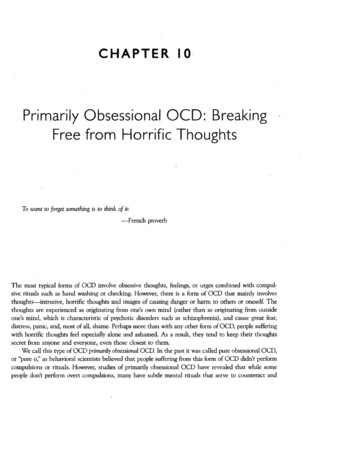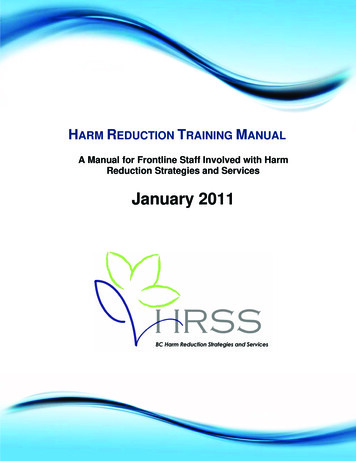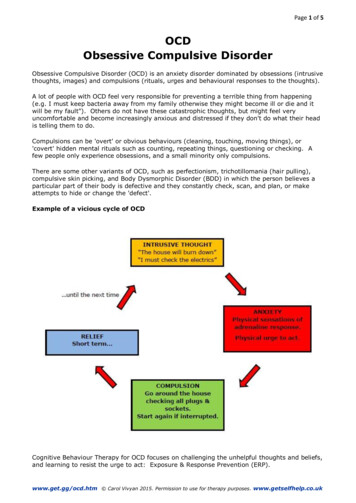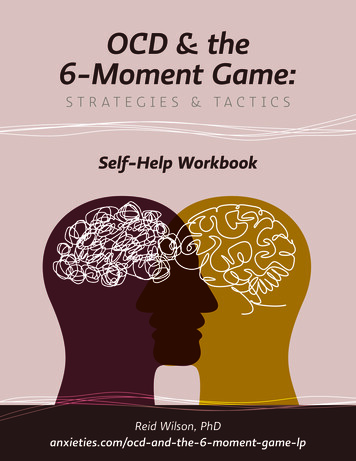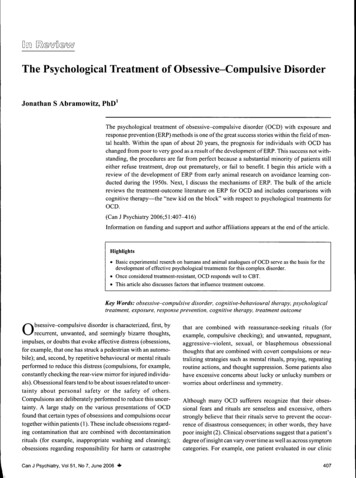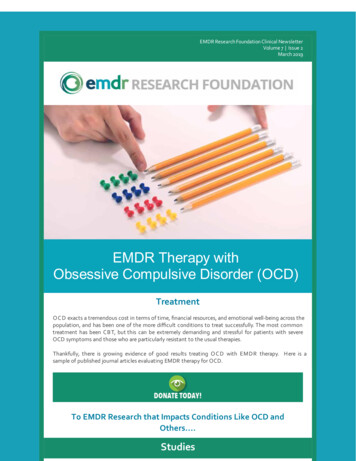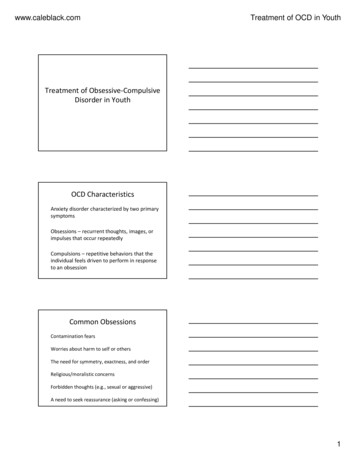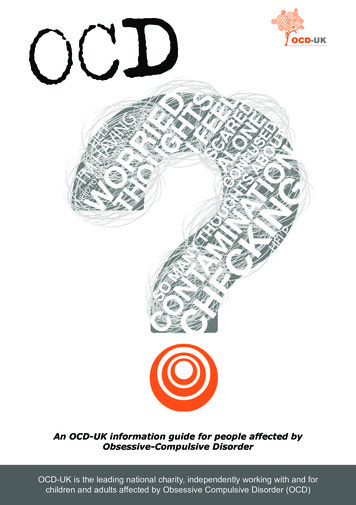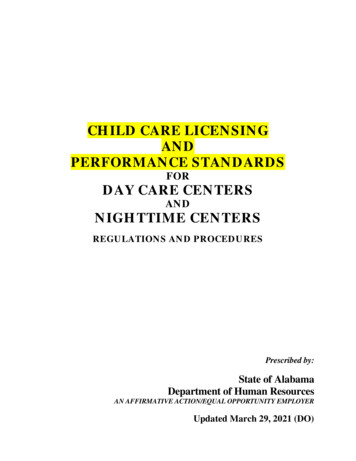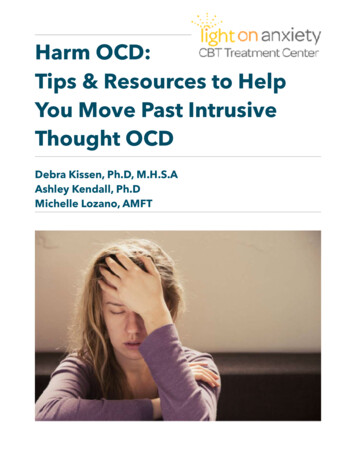
Transcription
Harm OCD:Tips & Resources to HelpYou Move Past IntrusiveThought OCDDebra Kissen, Ph.D, M.H.S.AAshley Kendall, Ph.DMichelle Lozano, AMFT
Section 1IntroductionWhy we wrote an eBookThe origin of this workbook was a Huffington Post blog on Harm OCD Dr.Debra Kissen, founder of Light On Anxiety CBT Treatment Center (Chicago, IL)wrote after a session with one of her wonderful patients who she was treatingfor harm OCD.While walking to grab lunch, Dr. Kissen was thinking how lovely her patient isand how she is such a pleasure to work with. From here, she started thinkingabout all of her other Harm OCD patients and started noticing a trend. Theywere all caring, conscientious, kind, and valued their relationships with lovedones above anything else in life. From this line of thinking Dr. Kissen wrote abrief blog on Harm OCD. The key message of the blog was to highlight howharm OCD goes after what you care most about and how, of the hundreds andhundreds of individuals who we have treated for harm OCD, we have yet tomeet someone struggling with harm OCD who we would distrust as a babysitteror teacher or health provider (and we can be quite picky on this front we onlywant kind, compassionate, conscientious care givers in our life).Shortly after posting this blog, Dr. Kissen began receiving messages fromreaders all over the world, stating how appreciative they were to have finallyfound information that shined light on their silent suffering. After so manymessages came in stating some version of“Thank you so much. You may very well“Thank youhave saved my life.” Dr. Kissen, Dr.so much.Kendall and another therapist at theirYou maypractice, Michelle Lozano, decided therewas too much unnecessary sufferingvery wellexperienced by those struggling withhave savedharm OCD symptoms and that the timemy life.”seemed right to offer all of the tools andtips that they currently offer patients
experiencing harm OCD in an eBook format, so this information can beaccessed by a broader audience.Section 2Good News About Harm OCDThe good news— yes, there is goodnews when it comes to OCD— is that itcan be effectively treated. Manyresearch studies have highlighted thatOCD symptoms can be reduced tonon-symptomatic levels by engaging inExposure and Response Prevention(ERP) based treatment.OCD was once thought to be one of themost serious and severe of mentalhealth disorders and unresponsive totreatment (Kobak 2004). HoweverERP has been documented to beeffective in treatment for OCD for overfive decades (Kobak 2004).Foa and Kozak’s 1996 review of 12outcome studies reported treatmentresponder rates of 83 among peoplewho completed treatment. In 16studies reporting long term outcomes, 76 percent were able to maintain theirtreatment gains over time. In addition to ERP, for harm OCD in particular, it isimportant to address the cognitive aspects of the disorder, for example thinkingerrors that lead one to believe a harm thought is equivalent to a harm behavior.This eBook offers a clinical intervention program based on the principles ofERP for OCD. As you move through this eBook you will learn a good deal moreabout ERP but for now, the main take away message for you is there is reasonto feel hopeful. In other words, your situation is NOT hopeless. You will not
always feel this bad. The discomfort you are experiencing is temporary. You areand will be OK!Pre-assessmentIt is helpful to fill out a pre-intervention assessment so you will be able toquantify the frequency and intensity of your symptoms and observe over time,as you put in the work in freeing yourself from, how these symptoms decrease.There will be a day when an intrusive thought will surface. You may be temptedto tell yourself, “See, I am still having these horrible thoughts. Nothing everchanges. I will always be stuck.” The hope is that you will then be able to do aquick assessment and review where you are, and how far you’ve come.In the past week, on average:How many hours a day do you think about your intrusive thoughts?How much distress do you experience when a harm IT surfaces?How much impairment does harm OCD cause in your life/how muchdoes it impact your ability to engage effectively in your life?Please think across all spheres such as:-Family Self care:-Other:
How hard are you currently trying to avoid or fight or make sense ofyour Harm related thoughts?How hard are you currently trying to engage in valued living and puttingyour attention on the aspects of life that are most important to you?This eBook is anappropriate firststep for thoseexperiencing mildto moderatedistress anddiscomfort. Forthose experiencingsevere impairment,we recommendthat the readerseek professionalassistance as thesesymptoms areimpacting functioning and creating a high level of distress and one should nothave to face that level of suffering alone, without professionally trainedassistance.In addition, if the reader is experiencing active suicidal thoughts or abusingsubstances, etc, then we recommend seeking out professional assistanceimmediately.
Section 3Why am I having such horrificthoughts?If you are reading this eBook, chances are you have wrestled with thoughts suchas “What is wrong with me? What kind of person has such disturbing thoughts?What do these thoughts say about me? Why would I be having these thoughtsunless on some level I wanted these disturbing things to happen? Am I safe tobe around? Could I harm myself or loved ones?”The fact that you are struggling with these questions, and that you find yourintrusive thoughts distressing— as opposed to enjoyable— lends support thatyou A) are not a monster, and B) have harm OCD. Not to mention the fact thatyou are spending precious moments of your life reading and engaging in thisworkbook seeking relief.To offer some foreshadowing into the material we will cover in later chapters,we cannot guarantee that you will not engage in some disturbing act in thefuture, just as we cannot guarantee that we will not engage in a reprehensiblebehavior in the future.Another way to assess if you are experiencing disturbing thoughts due to A)being a monster, or B) you have Harm OCD is to assess the behaviors you haveengaged in over the course of your life. The old saying “the best predictor offuture behavior is past behavior,” is quite accurate. So, look at each of yourharm OCD thoughts and ask yourself how many times in your life have you sofar engaged in the feared behavior.Example 1. Harm thought: “I am going to lose control and stab my spouse.”A) Assessment of prior behaviors in line with obsession: How many times inyour life have you stabbed your spouse?B) How many times have you had the thought that you stabbed your spouse?
Example 2. Harm thought: “I am going to lose control and harm myself.”A) Assessment of prior behaviors in line with obsession: How many times inyour life have you lost control and harmed yourself?”B) How many times have you had the thought that you stabbed your spouse?If you have answered 1 or more to questions A) above, this may not be the righttreatment approach. We recommend you review your responses with a trainedmental health provider to create the most effective treatment plan.Note: Some people experiencing harm OCD will answer affirmatively to thequestions above because they cannot perfectly prove to themselves that a pastbehavior was not in some way harm to self or others. If this is the case foryou, we recommend you continue reading. When one engages in a true harmrelated behavior, it is quite clear and not a murky matter.Section 4Common Harm OCD ObsessionsThere is always the moment, when treating a client for OCD, when we handthem the checklist of the most common obsessions, a look of relief and releaseof tension can be immediately seen. They state something like, “I can’t believethat others have these same disturbing thoughts and that they are so commonthat they are on a standard checklist.”We are glad to be able to provide you with this same moment of relief as yourealize just how unoriginal and run of the mill your most shocking intrusivethoughts are:I’m going to lose control and harm myselfI’m going to lose control and harm my loved onesI’m going to lose control and cheat on my partner
I’m going to lose control and say (or write) something inappropriateI am going to lose control and act out sexually in a way not in line with myself identity or valuesSection 5Reading About Harm OCD MakesMe AnxiousIf you are finding that reading this eBook is anxiety provoking thencongratulate yourself for taking one step closer to freeing yourself of harmOCD. The very act of intentionally bringing on and tolerating feelings of anxietywill be the secret sauce that helps you leave harm OCD in the dust, as youproceed forward with your life. We will get to this concept a good deal more aswe move forward in this workbook but for now know that it is not at all unusualto feel an increase in anxiety as one begins the work of facing Harm OCD headon.Exercise 1:Review words below and check off anythat you find anxiety provoking:HarmLosing tyMurderInsanityExercise 2:What is the scariest word you canthink of?On a scale of 0-10, how anxious doyou feel at this moment?On a scale of 0-10, how anxious doyou think you would be if you saidthat word out loud 100 times?
Section 6Case Examples of IndividualsExperiencing Harm OCDPeople with intrusive thought OCD often have deep feelings of shame abouttheir moral character, and struggle to imagine that anyone “normal” couldshare their thoughts. Here, we introduce you to four wonderful, highfunctioning people who have experienced harm OCD, based on client we haveworked with.This section will help you come to understand that you don’t have to be a“monster” to experience harm intrusive thoughts.“Stephanie,” A 33-year-old woman who teaches math and science in a secondgrade classroom and volunteers once a week as a math tutor for middleschoolers from low income neighborhoods.“Greg,” A 47-year-old man who worksas a lawyer during the day, and spendsmuch of his free time in the eveningsand on weekends with his wife andchildren.“Lucas,” A 38-year-old man who hasbeen successfully beginning his ownstart-up in the restaurant industry.“Chloe,” A 24-year-old woman whorecently graduated from college at thetop of her class and started her dreamjob in public relations for anenvironmental non-profit.The individuals described above are based on clients who have come to ourclinic seeking help for harm OCD.
Exercise: Match the intrusive thoughts below to the client above whoyou think is most likely to have had the particular concern.a. “I’m going to stab my wife and children.”b. “I’m going to wake up one night, smothering my wife with a pillow.”c. “I’m a pedophile.”d. “How can I be sure I’ve never had sex with a child? What if I justdon’t remember?”e. “I’m going to suddenly start swearing during a board meeting.”f. “I’m going to use a racial slur the next time I talk with an AfricanAmerican colleague.”g. “I’m going to go crazy on the subway to work, and they’ll have tostop the train to calm me down and everyone will realize I’ve lost mymind.”Answers:Stephanie: Thoughts c, dGreg: Thoughts a, bLucas: Thought gChloe: Thoughts e, fKey takeaway: We hope you’ve learned that experiencing a scary thought isnot the same thing as engaging in a scary behavior. Those struggling with HarmOCD are not “monsters”. They are simply regular people who are extremelyintolerant of having bad thoughts.
Section 7The Flip Side of Harm OCD isStrong ValuesExercise: For each of thepatients introduced in Section 6,list the values that you think he orshe holds most strongly.For example, do you think thatStephanie cares a great dealabout children?1. Stephanie:2. Greg:3. Lucas:4. Chloe:Harm OCD will only go after the things that really matter to you. If you don’tcare at all about your pets, harm OCD won’t be able to torment you with thethought, “What if I kill my dog?” Our own observation from seeing hundreds ofpatients with harm OCD is that they tend to be some of the kindest, mostconscientious and values-driven people we’ve ever known. This makes a lot ofsense when you consider that if a person didn’t have strong values, they won’tbe able to react strongly to intrusive thoughts that conflict with those values,and won’t fall into the cycle of shame and avoidance that perpetuates harmOCD.
Section 8Shame and SufferingAssociated with OCDAlthough the nature of their obsessions differed, one thing that Stephanie,Greg, Lucas, and Chloe all had in common was strong feelings of shame abouttheir own thinking. Each of them had waited several years—and in one caseover two decades—to come in for treatment. People with intrusive thoughtsoften suffer in silence, worried that if they confide in a professional, theclinician will assume the thoughts reflect true urges and diagnose the patient as“crazy,” perhaps even restraining them or reporting them to authorities.This leads to a nasty cycle for peoplewith harm OCD: the intrusive thoughtscreate feelings of shame, which lead toavoidance behaviors (for instance,avoiding talking about the thoughts, orbeing in situations in which thethoughts are likely to come up), in turnstrengthening the belief that OCDneeds to be avoided—which of coursejust feeds the OCD. The cycle goes onand on. The good news is that if you’rereading this eBook, you’re one stepcloser to freeing yourself from theshame of your intrusive thoughts.All of this hits on a key point that distinguishes harm-related intrusive thoughtsfrom thinking patterns in other types of OCD: Harm-related thoughts areegodystonic rather than egosyntonic. Egodystonic refers to impulses that aperson finds repulsive, unacceptable, and inconsistent with their own selfimage. Egosyntonic thoughts, feelings, or behaviors, by contrast, are inharmony with a person’s own ideals and self-image.
Activity 1: Identify if the OCD thought or behavior is egodystonic (e.g., a personwho loves children but worries he will sexually molest one) or egosyntonic (e.g.,a person who values cleanliness and compulsively washes her hands).Key takeaway: Unlike other types of OCD, the thoughts that goalong with harm OCD are most often egodystonic. This leads toincreased feelings of shame and suffering, but does not mean theperson who has these thoughts is “bad” or “immoral.” In fact, thethoughts are generally very much at odds with the person’sfundamental values.Section 9Who is “Better Person” GameExercise: Below, we describe different pairs of people. For each pair,identify the person you would be more likely to describe as a “good”person.Bob, who never gives up his seat on the train for the elderly or pregnant, cutspeople off on the road, and gives nothing to charity; orTodd, who has daily thoughts of losing control and stabbing his loved ones, butmakes a point to act toward people with kindness, and mentors a “youngerbrother” in the Big Brothers Big Sisters program.Jennifer, who reads and thinks regularly about the role of hunger inperpetuating global inequality but never acts on her concerns; orRita, who does not think nearly as deeply about the global ramifications ofhunger as Jennifer, but makes it a priority to volunteer twice a week at a soupkitchen.Key Takeaway: Most people would agree that it’s our concretebehaviors, not fleeting thoughts, that most define us as moral beings.
Section 10What’s the Flip Side of YourIntrusive ThoughtsNow that you’ve had practice identifying the values held by other patients withharm OCD, take some time to reflect on your own values, as revealed by yourintrusive thoughts.Exercise: Go back to Section 5, Exercise 1 and find the top fiveintrusive thoughts that you found most upsetting. List them.Next to each thought, describe the value that goes along with your fear.1.2.3.4.5.Section 11You Need Not Go Through theWork of Getting Help forHarm OCD AloneTo get the most out of this eBook, it is best to identify a friend or familymember or therapist to serve as an OCD coach. Harm OCD grows under thedarkness of shame and melts away when confronted with openness andacceptance. Even if your identified OCD coach plays a minimal role in the
actual treatment plan, it is still healing to discuss your symptoms with a lovedone. It will be a hard but powerful first step forward. It will help to confirmthere is nothing wrong with you but some scary thoughts that you arestruggling to make sense of.Exercise – list 2 people who could potentially serve as an OCD coach.1.2.Section 12Harm ITs Spam MailFor those experiencing OCDsymptoms, intrusive thoughts aresimply spam mail parading aspriority mail. Have you everreceived a spam email whichdescribed how a loved one isstranded in a foreign country withno money. How alarmed did youfeel once realizing this was spammail? But if your mother, father,child or best friend was in fact stranded in a foreign country with no money andno way to get back home, would you be concerned for them? You can us thissame discernment process to distinguish Harm OCD thoughts from truedanger.
Section 13Picking Up a Lab Coat and Setting Down yourJudgmental Mind: Viewing Your OwnThoughts like a Dispassionate ScientistNow we’re going to practice observing the thoughts that come into your mind likea scientist might: objectively, without getting caught up in the thoughts or judgingthem as “good” or “bad.” This means you simply describe the thoughts, sticking totheir objective qualities. It’s the difference between keeping your notepad out andwriting down the names of the characters on the screen, and getting so lost in ascene that you forget you’re outside of the film, instead getting emotionally lost inthe plot.Why is this “scientific” approach helpful? A few main reasons. By evaluating yourthoughts objectively, you create distance from them. They’re less gripping, and lesslikely to frighten you. Second, just the mere act of looking directly at your ownthoughts is a form of exposure, and will help decrease your anxiety, breaking theharm OCD cycle. Finally, once you get to know thoughts, you’ll be able to better
anticipate and work with them when they arise. You’ll recognize when they tend tocome and how they feel in your body and will be positioned to use skills toconfront rather than avoid the thoughts.Exercise: Pick a common stressful thought you have (but don’t go for aharm-related intrusive thought just yet).This should be something that bugs you, but not anything superdistressing. Record objective qualities of the thought, just as a scientistmight: the words that make up the thought (“There’s going to be a tonof traffic on my commute this morning.”, how your body respondswhen these words go through your mind (e.g., back muscles becometense), and any other thoughts that they lead to (e.g., “Maybe I shouldtake the train instead.”).Section 14Intrusive ThoughtTracking LogThe next step in getting to know your own thoughts—and taking away their power—is to understand patterns in when these thoughts come up. Although it might feellike you’re struck out of nowhere by gruesome images of driving your car onto acrowded sidewalk, for most people with harm OCD, the intrusive thoughts come atsomewhat predictable times. Just knowing this can make them less scary. Forexample, our patient “Lucas,” who cared a great deal about the success of his start-
up, found that he would worry about saying something inappropriate to a colleaguemost often around the time of important business decisions. For Chloe, whoworked in public relations, she discovered that her intrusive thoughts were tied toshifts in physical health: She was especially “vulnerable” to the thoughts when shehadn’t slept, was hung over from drinking, or was close to her period.Exercise: Over the next few days, use the following log to record thetime and place of your intrusive thoughts, along with where you were,the people you were around, and what you were doing when theycame up.After you’ve collected a few days’ worth of data, note any patterns you see in whenyour intrusive thoughts tend to come up. Are they more frequent during certaintimes of day? Around particular people? When you’re doing or thinking particularthings?Section 15Growing Bored of Your MostFrightening ThoughtsBelieve it or not, you can gettired of anything once you’vehad enough exposure to it.The human brain has anamazing ability to grow bored—it’s always looking forsomething new and exciting.This tendency to get used toand no longer react to stimuliis known as “habituation.”Just think of the movie buffwho has seen a horror film somany times she no longer feels frightened (or even interested) during the most
suspenseful scenes of the film. Or think of the teenager who nearly panickedwhenever he had to parallel park as he was first learning to drive, but now can doso almost without thinking.Exercise: come up with a list of things that used to be difficult or scary,but that you have habituated to and no longer find frightening. Howmight this be relevant to your intrusive thoughts?Section 16The Doubting Disorder:Doubt and UncertaintyThis section will outline how OCD gets activated atthe cross section of (1) what one values the most,(2) what one fears losing the most, (3) the lack ofcertainty that the feared event will not occur. Youmight notice from above, doubt is a common threadfor all harm obsessions.Some call OCD the doubting disorder because forall OCD concerns, there cannot be a guarantee thata feared outcome will not occur. OCD is notsatisfied with the knowledge that an outcome isextremely unlikely, it wants to know with certaintythat the thing that you most fear will not come true.Freedom from harm OCD does not entail removing all that a feared outcome willoccur (although that would be nice if it were true, unfortunately that does notprovide any of us with this kind of certainty). Instead freedom from harm OCDentails learning to live with the same smidgen of doubt that the “unthinkable” couldhappen, in the service of living a life worth living, in line with one’s values andaspirations.
Section 17Common Thinking Errors“Thinking errors” don’t refer to flaws in your thinking, so much as commoncognitive shortcuts we all take. We use these shortcuts on a daily basis, and theycan be adaptive, helping save us time and process information efficiently. At thesame time, they reflect a less complex type of thinking—one that often goes alongwith stress or anxiety. So if you notice that you’re engaging in several of these“thinking errors,” you might regard them as tiny red flags: indicators that you’reunder stress. This is important to see, as the thinking errors also often contribute toanxiety, reinforcing the very beliefs that are making you anxious in the first place.Below is a list of thinking errors common to people with Harm OCD.Intolerance of Uncertainty: You feel as if you must have a 100%guarantee of safety or absolute certainty. Any hint of doubt, ambiguity,or the possibility of negative outcome (however small) is unacceptable.This is the core distortion of OCD.Overestimation of Threat: You exaggerate the probability that anegative outcome will occur; or you exaggerate the seriousness of anynegative consequences.Overestimation of Responsibility: You believe that because youthink about harmful consequences, you are therefore responsible forpreventing harm from coming to yourself or others. Failure to prevent(or failure to try to prevent) harm is the same thing as causing harm.Significance of Thoughts: You believe that your negative obsessionalthoughts are overly important or very meaningful. For example, the ideathat there is something seriously wrong with your brain because youhave senseless thoughts.
Moral Thought-Action Fusion: You believe that your unwantedthoughts are morally equivalent to performing a terrible action.Therefore, you think you are an awful, immoral, or disgraceful personfor thinking these thoughts.Likelihood Thought-Action Fusion: You believe that thinking certainthoughts increases the chance that something terrible will happen. Forexample, “If I think about death, someone will die.”Need to Control Thoughts: Beliefs about the significance of thoughtslead you to feel the need to control your obsessional thoughts (andactions). You worry that if you don’t control (or try to control) unwantedthoughts, something terrible could happen that you could haveprevented. Some people worry they will act on their unwanted thoughtsunless the thoughts are suppressed.Intolerance of Anxiety: You feel that anxiety or discomfort will persistforever unless you do something to escape. Sometimes the fear is thatthe anxiety or emotional discomfort will spiral out of control or lead to“going crazy,” losing control, or other harmful consequences.The “Just Right” Error (Perfectionism): You feel that things must be“just right” or perfect in order to be comfortable. A related belief is thefeeling that things need to be “evened out” or symmetrical or else youwill always feel uncomfortable.Emotional reasoning: You assume that danger is present basedsimply on the fact that you are feeling anxious.(Source: Jonathan S. Abramowitz, ognitive distortions in ocd.doc)
Exercise: Go back and next to each thinking error, write an examplefrom your own life. For example, our patient “Greg” wrote next to thethought-action fusion thinking error his own common thought, “If I haveimages of stabbing my wife, it makes it more likely to happen, so I needto suppress those images.”Section 18Your Brain on OCDYou may have heard aboutthe fear network in the brain“fight or flight response”.This is what gets triggeredwhen experiencing a trueemergency such as if youwere trapped in a burningbuilding or if your child isabout to get hit by a vehicle.The fight or flight responseis immediate. Ifexperiencing a trueemergency, it is not a time tothink and act slowly aboutsomething. The only goal is to attempt to survive.The OCD network of the brain is a bit different. It involves the part of the brain thatsounds the signal “something is wrong,” but it also involves the part of the brainthat says “you must take some kind of action now to fix the current situation.”The part of the brain signaling you to look for some way to fix the problem at handinteracts with motor planning and increases urge to do something to fix or solve aproblem. So the difference between a panic attack, which is an immediate “fight orflight response” and an OCD attack is that when the brain is “on OCD” it believessomething dangerous may happen but could potentially be prevented if certainprecautions (otherwise known as compulsions) are taken.
Section 19OCD, AKA The Bully WithinImagine a bully is in theschoolyard , “You better giveme your lunch money orelse .”. What are youroptions? You can give him (orher) your lunch money andhe/she may back off for abit until the next time thebully is hungry and nowknows you have lunch moneyprime for the taking.Or you can stand up to thebully and say, “I will not giveyou what is mine so back off.”Your OCD is similarly a bully, taunting youwith threats such as “If you are not carefulenough you can lose control and kill yourchildren.” And what the OCD bully wants isfor you to check and obtain reassurance andto review all of your behaviors to make surethat you will not lose control and engage in aterrifying behavior.Prior to reading this eBook you may haveassumed that the bully means business. Youmay have been willing to hand over yourlunch money (in your case, your life) to thebully in exchange for its protection againstYOU. But the good news is that you don’tneed protection from YOU. Now is the timeto look the OCD bully in the eyes and say,“You can’t mess with me. Just because youare telling me I am unsafe and out of control,does not mean it is true.”Section 19Whatever You Do– Don’tThinkIf you are reading this eBook, chances are you have already tried many things toget rid of your harm OCD. One of the first, and most logical strategies that peopletry when experiencing harm OCD is distraction. It is common to play video games,watch TV, the web, or to do just about anything, as long it does not entail thinking
about harm obsessions. The challenge is we humans are not very good at “notthinking” about things. The more we try to “not think” about panic, or bananas orflying pigs, or any other topic, the more we find ourselves thinking about it. Thereason for this phenomena is that the only way to know if we are successfully “notthinking” about a topic is to scan our minds for that content. By scanning ourminds to see if we are having a thought, we thereby trigger the unwanted thought.Exercise: Take a moment and conjure up a mental picture of a pinkelephant. Picture his pink trunk, his big, pink, floppyears. Now for the next minute, your job is to thinkabout any topic except for the pink elephant.Remember, whatever you do, don’t think about thepink elephant. So, how did it go?Section 20Common CompulsionsClients seeking treatment for harm OCD often come to us stating that they are notengaging in any compulsions and are only experiencing the O (obsession)component of OCD. Upon further investigation and exploration, we are quicklyable to come up with several compulsions that they are engaging in on a frequentbasis. The challenge in identifying the compulsion component of harm OCD isoften unlike checking locks or washing hands or organizing objects, mentalcompulsions can be hard to recognize.Common compulsions associated with harm OCD:Trying to “figure it out”GooglingMental reviewingReassurance seeking from othersAvoidance (parts the kitchen with knives, etc., African-American co-worker)Checking
ConfessingChecking arousal level around feared peopleSection 21Trying to Make Sense of th
The origin of this workbook was a Huffington Post blog on Harm OCD Dr. Debra Kissen, founder of Light On Anxiety CBT Treatment Center (Chicago, IL) wrote after a session with one of her wonderful patients who she was treating for harm OCD. While walking to grab lunch, Dr. Kissen was thinking how lovely her patient is
